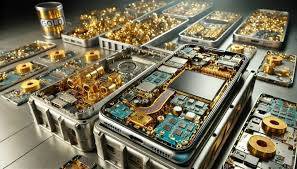Simple Method to Extract Gold from Electronic Gadgets
Gold is widely used in electronic gadgets due to its excellent conductivity and resistance to corrosion. Components such as connectors, circuit boards, and chips often contain small amounts of gold. Extracting gold from electronic gadgets, like old smartphones, computers, and circuit boards, can be an interesting and rewarding process. However, it requires careful handling, as it involves chemicals and can be hazardous if not done correctly. In this article, we will explore a simple method for extracting gold from electronic gadgets, particularly focusing on a process that can be done at home with some basic safety precautions.
Why Gold is Used in Electronics
Gold is a preferred material in electronics because of its superior electrical conductivity, corrosion resistance, and durability. In gadgets such as smartphones, laptops, and TVs, gold is often found in the following parts:
- Gold Plated Pins and Connectors: These are commonly found on circuit boards, connectors, and memory chips.
- Gold-Plated Circuit Boards: Many circuit boards use a thin layer of gold for better signal transmission.
- Gold-Plated Chips: Some processors and memory modules contain small gold contacts.
Steps to Extract Gold from Electronic Gadgets
While the process can be complex and involve the use of hazardous chemicals, a relatively simple and safer method involves using a gold recovery solution. Here’s a step-by-step guide on how to extract gold from electronic components at home.
Materials Needed:
- Old electronic gadgets (e.g., smartphones, old circuit boards, computer components)
- Screwdriver and small tools for dismantling gadgets
- A plastic container
- Protective gloves and goggles
- Hydrochloric acid (HCl)
- Hydrogen peroxide (H2O2)
- A heat source (e.g., a stove or hot plate)
- Gold recovery solution or aqua regia (optional)
- Tweezers or tongs
- Filter paper or mesh (for separating gold)
Step 1: Dismantling the Electronic Gadgets
The first step is to disassemble the gadget and carefully remove any electronic components that may contain gold. Using a screwdriver, open up the device and remove components like:
- Circuit boards
- Memory chips
- Connectors
- CPU or other chips with gold pins
Be careful to avoid damaging the components, as they may contain valuable gold.
Step 2: Cleaning the Components
After dismantling the device, clean the components to remove any dirt, plastic, or other debris. You can use water and a soft brush to clean the components, ensuring they are free from any impurities. Dry them thoroughly.
Step 3: Preparing the Gold Recovery Solution
For a simple extraction process, you can use a mixture of hydrochloric acid (HCl) and hydrogen peroxide (H2O2), which is an effective way to dissolve non-gold metals while leaving the gold behind. This method is often called the “gold chloride†method.
- Mix 1 part hydrogen peroxide with 3 parts hydrochloric acid in a plastic container. The solution should be used with caution, as both chemicals are highly corrosive.
- Always wear gloves and goggles for protection when handling these chemicals.
Step 4: Dissolving the Base Metals
Place the electronic components into the container with the hydrochloric acid and hydrogen peroxide solution. The mixture will start to dissolve other metals like copper and silver while leaving the gold intact. This process may take a few hours to a couple of days, depending on the amount of material you are processing.
- Stir the mixture occasionally, but avoid splashing the solution.
- The base metals will dissolve into the solution, and the gold will settle at the bottom of the container as a residue.
Step 5: Filtering the Solution
Once the metals are dissolved and only gold remains, carefully filter the solution using filter paper or mesh to separate the gold particles from the liquid. Be careful not to lose any of the gold during this step.
Step 6: Refining the Gold
The gold extracted will still contain impurities. To refine the gold, you can use a gold recovery solution (available commercially) or, for a more advanced method, aqua regia—a mixture of hydrochloric acid and nitric acid that dissolves gold. This is a more advanced process and should only be done by those familiar with the proper safety measures.
After refining, you can heat the gold powder in a crucible to melt it into a solid gold ingot.
Safety Precautions
Handling chemicals and performing the gold extraction process can be dangerous. Always wear protective gloves, goggles, and a face mask to prevent exposure to harmful fumes. Perform the procedure in a well-ventilated area, preferably outdoors. Never mix chemicals unless you are sure of the reaction and take proper disposal measures for used chemicals.
Conclusion
Extracting gold from electronic gadgets can be a fascinating and potentially profitable process, especially if you have a large amount of old electronics lying around. While the method described here is one of the simpler ways to recover gold, it still involves handling hazardous chemicals, so safety is paramount. For those looking to recover small amounts of gold from old electronics, this can be a rewarding project, but always proceed with caution and ensure you follow safety protocols.


